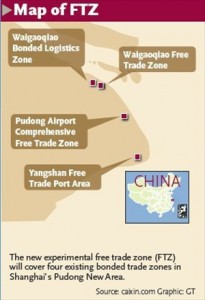The Chinese government has announced the piloting of four test Free Trade Zones (FTZ) in Shanghai aimed at facilitating the growth of the country’s trade, investment and financial services sectors. Shanghai is testing four zones first, with Tianjin and Xiamen set to follow suit. Tianjin filed its proposal to the central government, while the city government of Xiamen, Fujian province, is collecting documents to submit to the State Council for approval.
We opportunities where U.S. companies can take advantage of the pilot zones. Diana Maure, Pricing Manager of LILLY + Associates states, “although the China Free Trade Zone (FTZ) is in the early stage of discussion, U.S. exporters into China could potentially benefit from the proposed FTZ by affording them the flexibility to combine originating and non-originating materials within the zone and defer duties of non-originating goods if transshipped into other nearby markets. With nearby emerging markets close to the proposed FTZs, this opens new opportunities for U.S. exporters to use China as a nearby warehousing and distribution hub for the Far East. The ocean shipping hub will also allow a benefit of securing frequent sailings for easy transshipment options to neighboring countries.”
For distributors, this allows a company to import into China with eased import customs restrictions, assemble and distribute in a FTZ and then export out of the country duty-free to nearby markets. The ocean shipping hub that surrounds the pilot FTZs allow for greater shipper flexibility and options when exporting out of the company. Greater shipping options will be advantageous for shippers who optimize a just-in-time inventory as the goods will be able to move out of the country and into a new market quickly and cost-efficiently (when compared to a majority of other geographic locations).
Maure also sees opportunities where China can take advantage of its location and the nearby markets, “From another standpoint, the emergence of a China FTZ would allow materials sourced from other countries (raw materials, parts, fabric) to be assembled in the proposed FTZ and then exported out of the country duty-free assuming that all materials are imported (and the proposed FTZ operates the same way as other existing zones). This zone would not only affect duties, but allow the supply chain to become leaner in general with the easing of customs approvals.”




